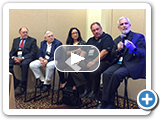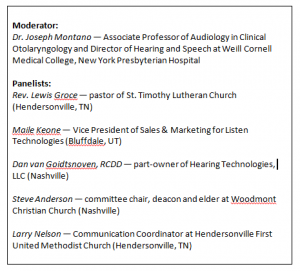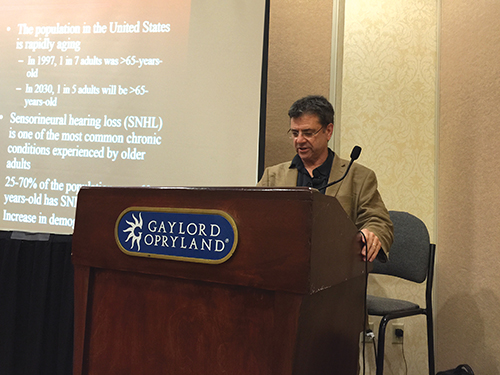
Achieving Accessible, Inclusive Churches
Highlights from a Church Executive panel discussion on accommodating worshipers with hearing loss
By RaeAnn Slaybaugh

Recently, Church Executive led a live panel discussion to examine the risks churches face by failing to provide a welcoming, inclusive worship experience for all — including worshipers with hearing loss.
Here are some highlights from this informative discussion.
A silent (yet widespread) disability
“By 2030, one out of five adults will have hearing loss. Right now, about 25 to 60 percent of the 60-plus population has sensory-neural hearing loss. Even so, one stereotype is that wearing a hearing aid makes you look old. So, people tend to live with hearing loss long before they get a hearing aid. In fact, only about 25 percent of people who need hearing aids actually get them.”
— Dr. Joseph Montano
 A true ministry opportunity
A true ministry opportunity
“We had a loop installed at our church three years ago. Almost every Sunday, people come up and say, ‘I’m hearing things I haven’t heard before.’”
— Larry Nelson
“Hearing loss leads to depression and anxiety. Social isolation (not attending worship services) is one of the most common aspects, which leads to disengagement — meaning they just tune out during worship. Church services are spiritual and religious in nature, but they’re also social environments.”
— Dr. Joseph Montano
System options, explained
“With a loop, the vast majority of users are wearing a device in their hearing aids called a ‘T-switch.’ So, when they come in to the church, put their hearing aids into the t-position, and those will act the same way as a personal receiver, but amplified.”
— Dr. Joseph Montano
“There are three basic types of assistive listening systems: FM (RF), IR (Infrared) and induction loop. A loop takes the sound from the mic and puts it directly into the loop, which goes directly to your ear if you have a T-switch-enabled hearing aid. It will be physically put in to the building; it’s permanently installed.

“The FM system requires you to wear a receiver around your neck. And, IR is the same kind of thing as FM; it’s just infrared.”
— Dan van Goidtsnoven, RCDD
“It’s really important to decide what technology is the right technology for your house of worship. Cost is a factor, of course. But also, do you have carpet or tile or concrete floors? It’s great to have a professional help you vet those considerations.”
— Maile Keone
An education process
“There’s a whole ecosystem around successful implementation of assistive listening technology in house of worship. There’s the technology, but also education, signage — you really have to be intentional. You can’t just buy it, and then ‘set it and forget it.’”
— Maile Keone
“Now that we’ve got our loop installed and have educated people on its use, every few months I put an article in the e-newsletter that explains it again and encourages members to invite their friends and family with hearing aids to attend worship services. Or, if they’re buying new hearing aids, to consider a T-switch-enabled one.”
— Larry Nelson
It (often) takes a champion
“When we decided to put in a hearing loop, it was because there was an advocate in our congregation. That was important: having an advocate to say, ‘This is significant to me, and it’s significant to a lot of other people.’”
— Rev. Lewis Groce
“Our church’s loop advocate is a real charming person, and insistent. She wanted the problem alleviated for herself and for others.”
— Steve Anderson
“Someone on our board of trustees had heard about the need [for an assistive listening system] and brought it forward. There was very little resistance, if any, to its implementation.”
— Larry Nelson

Key building / installation considerations
“We were remodeling the sanctuary at time of installation. It was perfect.”
— Larry Nelson
“We retrofitted our sanctuary [to accommodate the hearing loop]. We had a slate floor. The installers went in with a Dremel-like tool and took out the grout. The wire went in, and there was no problem.”
— Rev. Lewis Groce
“I want to speak to the issue of ‘ripping up the carpet.’ The loop installers don’t rip it up; they curl it on the edge, put the wire in there, and lower it back down. You can’t tell anything was done, and it doesn’t really take long.”
— Steve Anderson
Suited for non-sanctuary spaces, too
“Two years after our sanctuary hearing loop was put in, we’re building a fellowship hall. There was no question about whether or not we’d loop the new space.”
— Rev. Lewis Groce
“From an installation standpoint, we’ve installed loops in many church meeting rooms and cry rooms. This morning, we did a survey for a sanctuary, a fellowship hall and a small meeting room at a church.”
— Dan van Goidtsnoven, RCDD
Not a “new” technology
“Really, looping has been around for a long time. Classrooms in the 1960’s were often looped.”
— Dr. Joseph Montano
“Yes! As is every taxicab in New York. Over the next 10 years, I believe, they’re phasing them in.
“The Europeans are so far ahead of us in terms of hearing technology. There, you find systems at pharmacies, ballparks, in subways — anywhere there’s voice transfer. Even trains and buses are looped.”
— Maile Keone
Funding the solution
“To pay for our loop systems, we founded partnerships with civic organizations — groups that used our facility and were familiar with us. We also used memorial funds from people who knew someone to whom this technology was (or would have been) significant. And, we designated funds in the ministry plan.”
— Rev. Lewis Groce
“We have a finance committee, and they had to sign off. They didn’t give much resistance.”
— Steve Anderson
“We had an advocate for the loop, and it was pretty simple to get the church to say, ‘Yes, let’s move forward with this.’”
— Larry Nelson
“Often, there’s someone in the congregation who can’t hear. They’ll say, ‘I don’t care what it costs; you [the church] go find the solution and I’ll write a check.’ We actually hear that quite a bit.”
— Maile Keone

Multiple systems might be ideal
“I believe 70 percent of hearing aid users have T-switch-enabled hearing aids. So, if you have a loop in your church, you’re potentially leaving out 30 percent of the potential users. You still need to have FM or IR receivers if you want to serve 100 percent of your population.”
— Maile Keone
“We have a loop, but we also have some receivers because not everyone has a T-switch. Every Sunday, several people bring their own earbuds, and they’re compatible with the neck loops.”
— Larry Nelson
“I really like the individual units. When someone in the congregation says, ‘I don’t think I need a hearing aid’ — oh man, it makes a huge difference! As much as a person might like the sermon and be able to hear it well, there’s a lot of other things happening, too. As long as those things are running through your sound system, users of these units don’t have to miss out.”
— Rev. Lewis Groce
“When I talk about hearing loss, I frequently talk about it in the context of a journey — someone’s acceptance of the issue and then getting the help they need. Any time they have an experience like Rev. Groce alluded to, it’s really an eye-opener.”
— Dr. Joseph Montano
Language translation: another application
“The technology absolutely supports language translation. Some of our house-of-worship customers say they love using it in this way because they don’t have to have separate worship services for
different languages.”
— Maile Keone
“For language translation, a church is going to need an FM or IR system.”
— Dan van Goidtsnoven, RCDD


